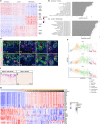Single-cell RNA sequencing reveals differential cell cycle activity in key cell populations during nephrogenesis
- PMID: 34789782
- PMCID: PMC8599654
- DOI: 10.1038/s41598-021-01790-6
Single-cell RNA sequencing reveals differential cell cycle activity in key cell populations during nephrogenesis
Abstract
The kidney is a complex organ composed of more than 30 terminally differentiated cell types that all are required to perform its numerous homeostatic functions. Defects in kidney development are a significant cause of chronic kidney disease in children, which can lead to kidney failure that can only be treated by transplant or dialysis. A better understanding of molecular mechanisms that drive kidney development is important for designing strategies to enhance renal repair and regeneration. In this study, we profiled gene expression in the developing mouse kidney at embryonic day 14.5 at single-cell resolution. Consistent with previous studies, clusters with distinct transcriptional signatures clearly identify major compartments and cell types of the developing kidney. Cell cycle activity distinguishes between the "primed" and "self-renewing" sub-populations of nephron progenitors, with increased expression of the cell cycle-related genes Birc5, Cdca3, Smc2 and Smc4 in "primed" nephron progenitors. In addition, augmented expression of cell cycle related genes Birc5, Cks2, Ccnb1, Ccnd1 and Tuba1a/b was detected in immature distal tubules, suggesting cell cycle regulation may be required for early events of nephron patterning and tubular fusion between the distal nephron and collecting duct epithelia.
© 2021. The Author(s).
Conflict of interest statement
The authors declare no competing interests. Our study with observational experimental design was carried out in compliance with the ARRIVE guidelines.
Figures





Similar articles
-
Single cell RNA sequencing uncovers cellular developmental sequences and novel potential intercellular communications in embryonic kidney.Sci Rep. 2021 Jan 8;11(1):73. doi: 10.1038/s41598-020-80154-y. Sci Rep. 2021. PMID: 33420268 Free PMC article.
-
Single cell analysis of the developing mouse kidney provides deeper insight into marker gene expression and ligand-receptor crosstalk.Development. 2019 Jun 12;146(12):dev178673. doi: 10.1242/dev.178673. Development. 2019. PMID: 31118232
-
Sex-specific proximal tubular cell differentiation pathways identified by single-nucleus RNA sequencing.Sci Rep. 2024 Oct 14;14(1):24041. doi: 10.1038/s41598-024-73102-7. Sci Rep. 2024. PMID: 39402239 Free PMC article.
-
Epigenetic States of nephron progenitors and epithelial differentiation.J Cell Biochem. 2015 Jun;116(6):893-902. doi: 10.1002/jcb.25048. J Cell Biochem. 2015. PMID: 25560433 Free PMC article. Review.
-
Renal-Tubule Epithelial Cell Nomenclature for Single-Cell RNA-Sequencing Studies.J Am Soc Nephrol. 2019 Aug;30(8):1358-1364. doi: 10.1681/ASN.2019040415. Epub 2019 Jun 28. J Am Soc Nephrol. 2019. PMID: 31253652 Free PMC article. Review. No abstract available.
Cited by
-
Global trends and hotspots in Cyclin-dependent Kinase Subunit 2 research from 1999 to 2022: A bibliometric and visualized analysis.Medicine (Baltimore). 2023 Dec 1;102(48):e36319. doi: 10.1097/MD.0000000000036319. Medicine (Baltimore). 2023. PMID: 38050288 Free PMC article.
-
Aberrant activation of IL-6/JAK/STAT3/FOSL1 signaling induces renal abnormalities in a Xenopus model of Joubert syndrome-related disorders.J Biol Chem. 2025 Jun 24;301(8):110413. doi: 10.1016/j.jbc.2025.110413. Online ahead of print. J Biol Chem. 2025. PMID: 40570958 Free PMC article.
-
Vascular endothelial cell development and diversity.Nat Rev Cardiol. 2023 Mar;20(3):197-210. doi: 10.1038/s41569-022-00770-1. Epub 2022 Oct 5. Nat Rev Cardiol. 2023. PMID: 36198871 Free PMC article. Review.
-
Podocytes in health and glomerular disease.Front Cell Dev Biol. 2025 Apr 24;13:1564847. doi: 10.3389/fcell.2025.1564847. eCollection 2025. Front Cell Dev Biol. 2025. PMID: 40342933 Free PMC article. Review.
-
Nephron progenitors rhythmically alternate between renewal and differentiation phases that synchronize with kidney branching morphogenesis.bioRxiv [Preprint]. 2024 Jan 13:2023.11.21.568157. doi: 10.1101/2023.11.21.568157. bioRxiv. 2024. PMID: 38045273 Free PMC article. Preprint.
References
Publication types
MeSH terms
Grants and funding
LinkOut - more resources
Full Text Sources
Molecular Biology Databases
Research Materials
Miscellaneous

